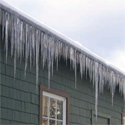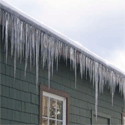Freeze frame
At a glance, the icicles dangling from the edge of a house on a cold day all look pretty much like long, inverted cones. Look more closely though, and it is possible to see they are not perfectly conical, but more subtly curved, like a carrot.
Despite the many parameters involved, theorists have predicted that icicles, as well as other natural features like stalactites, should all converge to the same shape as they grow. In a paper appearing in Physical Review E, Antony Chen and Stephen Morris at the University of Toronto, Canada, describe an experimental setup that allows them to image icicles as they grow under controlled conditions, and test these predictions. They mounted a camera through a slot in the side of a refrigerator, within which icicles formed as water dripped from a nozzle and onto a rotating wooden support. Rotating the support helps even out the effects of drafts and temperature gradients.
Chen and Morris imaged icicles, documenting the shapes of fully grown icicles formed from both frozen tap and distilled water. For the most part, the shape of icicles follows a simple theoretical prediction: the diameter varies as the distance from the tip to the th power (i.e., it is sublinear). Where this relation fails, one culprit is the purity of the water. Tap water has more impurities and a lower surface tension, which Chen and Morris find makes icicles more susceptible to bending, twisting, and forming ripples along their sides. – Jessica Thomas





